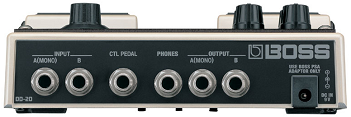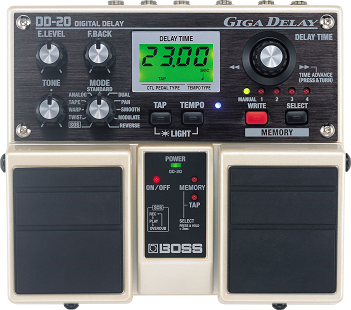DD-20
Boss DD-20 GigaDelay. This is actually a rather complicated pedal, and there are a couple of modifications available to reduce the white noise in the operation of the pedal. These are detailed below under "modifications". This double-pedal has been discontinued by Boss. While there are some complaints about the digital codec in the pedal not providing repeats in a fidelity that is as high as possible, we haven't noticed an issue. That said, this pedal is very versatile and has many features that most players might not ever necessarily use in the course of their performing. We are a bit surprised that production of the DD-20 was ended, but that the Boss RE-20 Space Echo continues to be produced. It would seem the DD-20 didn't sell as well as the RE-20.
Despite the fact that the DD-20 has since been obsolesced by the Boss DD-500, it's interesting to note that for 40 years Boss has been successful with pedals employing broad "metal cap/flap"-style footswitches. With the new success of Dunlop/MXR, and along with legions of boutique and home builders that use the simple button switches, it seems Digitech/DOD has been coaxed away from their previous transition to the Boss-style "metal cap/flap" switch and back to the button switch. Much of this seems to do with the fact that players have come to perceive that a button switch on the pedal signals that it's always true bypass. This seems in turn to have put Boss on the defensive and now Boss has returned to their CE-1 era button style footswitches for certain pedals, even if those switches do nothing to actually make the pedal true bypass.
Controls
- Knob 1 - "E. Level": (Effect Level) Fully counter-clockwise results in an inaudible delay effect. Fully clockwise results in repeats that are just as loud as the original dry signal before tapering off.
- Knob 2 - "F. Back": (Feedback) Select the number and intensity of repeats starting at fully counter-clockwise with one repeat and fully clockwise resulting in enough repeats to begin self-oscillating.
- Knob 3 - "Tone": Turned fully counter-clockwise this knob emphasizes bass; turned fully clockwise emphasizes treble frequencies in the delayed signal. The knob at noon results in delay repeats without and frequency alteration.
- Knob 4 - "Mode": Use the Mode knob to select among several delay types:
- Sound on Sound (SOS): "sampler" Record loops and then record on top of the loop you've already recorded.
- Twist: Causes an acceleration in the delay and shifts the delayed note pitch up when the left pedal is depressed. When the pedal is released, the delay slows down and the pitch drops back down.
- Warp: When the left pedal is pressed the number of delay repeats slowly increases. When pedal is released the number of delay repeats slowly returns to original setting.
- Tape: Results in an effect similar to a tape delay where additional tape heads pick up signal and play it back. Imagine having 2 full volume repeats instead of one and then the same pattern for the repeats themselves as the volume on those repeats decays.
- Analog: Frequency-tuned to sound like an analog delay. Treble frequencies are rolled off for delay repeats.
- Standard: Unmodified digital delay
- Dual: Sort of a slapback effect, not unlike the "Tape" setting but with far less time between the delay repeats. Creates almost a small-room reverb tone.
- Pan: Bounces the delay effect between the left and right stereo outputs
- Smooth: A delay effect with the addition of a built-in Reverb.
- Modulate: Modulates the delay sound. As if you put your delay-wet output through a chorus pedal.
- Reverse : A reverse-gated delay sound, makes your instrument sound like it's being played on a tape or record being played backwards.
- Knob 5 - "Delay Time":
- simple knob-turn: speed up or slow down delay on order of milliseconds.
- push-down and knob turn: speed up or slow down delay on order of hundreds of milliseconds.
- Footswitch 1 (left) - "On/Off": This turns the pedal On and Off
- Footswitch 2 (right) - "Select": Depending on the modes set for the pedal, this switch selects from each of the 4 banks
- Button 1 - "Tap": Tap this button to set the repeats to match your tempo. Top of the unit has a 1/4" instrument jack plugging in an additional pedal for use as tap tempo.
- Button 2 - "Tempo": Changes manner of Tap Tempo operation: quarter-note to triplets to dotted whole note.
- Buttons 1 & 2 together: "Light": This controls whether the backlight on the digital display is on or off.
- Button (red) 3 - "Write":
- Button 4 - "Select":
Input and Output Jacks
- Input A (mono)
- Input B
- Control Pedal input
- Headphones Out
- Output A (mono - dry + wet)
- Output B (stereo or only Input B)
- AC Adapter input
If only Input A has a instrument plugged in, it's possible to use Output A and Output B. Output A will be the "dry" signal and Output B will be the "wet" signal with all the delay repeats.
If Inputs A and B have instruments plugged in, Output A will have the dry + wet signal for Input A, while Output B will have the dry + wet signal for Input B.
General Information
If you're using the pedal long-term in your signal chain, it'll help for you to configure the pedal to remember the different modes that you'd like for it to start up with in default when you power the pedal on.
Pedal Modes
Output Modes
- Mode 1: The DD-20 is set to accept an instrument-level (-10 dB) signal into Input A.
- Use this mode when the delay is being used between an instrument and an amplifier
- Mode 2: -10 dB Basic instrument level signal, Output A = Dry, Output B=Wet
- Use this mode when you have separate instruments or separate signals for Input A and B, and Output A and Output B are individually going to separate amplifiers.
- Example: 1 instrument into a chorus pedal with stereo outputs, and then plugging the left chorus output into DD-20 Input A and the right chorus output into DD-20 Input B.
- Use this mode when you have separate instruments or separate signals for Input A and B, and Output A and Output B are individually going to separate amplifiers.
- Mode 3: DD-20 is set to expect line-level (+4 dB) signal into Input A. This function can be enabled at Power-On by pressing down the left pedal down plugging in the AC adapter
- Use this mode when the DD-20 is being used in an amplifier's effects loop.
- Mode 4: DD-20 is set to expect 4 dB into both Inputs.
- Technically it's possible to use the DD-20 in two amplifier effects loops, with each loop using a single input and output before returning to their respective amplifier effects loops returns.
Looping Features
Sound-on-Sound mode.
Modifications
http://music-electronics-forum.com/t16606/
Pedal Manual
https://static.roland.com/assets/media/pdf/DD-20_OM.pdf
Phase Inversion
No schematic means that we're unable to determine, without an oscilloscope, if the DD-20 inverts the signal phase. That said, the schematic is probably so complicated that it would be almost impossible for the lay person to be able to trace and determine whether this pedal inverts. Once we get it up on a bench with an oscilloscope, we'll report here if the phase is inverted.
Schematic
None available.
Artists
- Additional Sources

